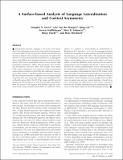| dc.contributor.author | Greve, Douglas N. | |
| dc.contributor.author | Van der Haegen, Lise | |
| dc.contributor.author | Cai, Qing | |
| dc.contributor.author | Stufflebeam, Steven | |
| dc.contributor.author | Sabuncu, Mert R. | |
| dc.contributor.author | Fischl, Bruce | |
| dc.contributor.author | Brysbaert, Marc | |
| dc.date.accessioned | 2013-10-07T12:34:40Z | |
| dc.date.available | 2013-10-07T12:34:40Z | |
| dc.date.issued | 2013-07 | |
| dc.identifier.issn | 0898-929X | |
| dc.identifier.issn | 1530-8898 | |
| dc.identifier.uri | http://hdl.handle.net/1721.1/81337 | |
| dc.description.abstract | Among brain functions, language is one of the most lateralized. Cortical language areas are also some of the most asymmetrical in the brain. An open question is whether the asymmetry in function is linked to the asymmetry in anatomy. To address this question, we measured anatomical asymmetry in 34 participants shown with fMRI to have language dominance of the left hemisphere (LLD) and 21 participants shown to have atypical right hemisphere dominance (RLD). All participants were healthy and left-handed, and most (80%) were female. Gray matter (GM) volume asymmetry was measured using an automated surface-based technique in both ROIs and exploratory analyses. In the ROI analysis, a significant difference between LLD and RLD was found in the insula. No differences were found in planum temporale (PT), pars opercularis (POp), pars triangularis (PTr), or Heschl's gyrus (HG). The PT, POp, insula, and HG were all significantly left lateralized in both LLD and RLD participants. Both the positive and negative ROI findings replicate a previous study using manually labeled ROIs in a different cohort [Keller, S. S., Roberts, N., Garcia-Finana, M., Mohammadi, S., Ringelstein, E. B., Knecht, S., et al. Can the language-dominant hemisphere be predicted by brain anatomy? Journal of Cognitive Neuroscience, 23, 2013–2029, 2011]. The exploratory analysis was accomplished using a new surface-based registration that aligns cortical folding patterns across both subject and hemisphere. A small but significant cluster was found in the superior temporal gyrus that overlapped with the PT. A cluster was also found in the ventral occipitotemporal cortex corresponding to the visual word recognition area. The surface-based analysis also makes it possible to disentangle the effects of GM volume, thickness, and surface area while removing the effects of curvature. For both the ROI and exploratory analyses, the difference between LLD and RLD volume laterality was most strongly driven by differences in surface area and not cortical thickness. Overall, there were surprisingly few differences in GM volume asymmetry between LLD and RLD indicating that gross morphometric asymmetry is only subtly related to functional language laterality. | en_US |
| dc.description.sponsorship | National Institutes of Health (U.S.) (R01NS052585-03) | en_US |
| dc.description.sponsorship | National Institute on Aging (5R01AG029411) | en_US |
| dc.description.sponsorship | National Institute on Aging (5R01AG022381-08) | en_US |
| dc.description.sponsorship | National Institute of Neurological Disorders and Stroke (U.S.) (1R01NS069696-01A1) | en_US |
| dc.description.sponsorship | National Center for Research Resources (U.S.) (P41-RR14075) | en_US |
| dc.description.sponsorship | National Center for Research Resources (U.S.) (R01 RR16594-01A1) | en_US |
| dc.description.sponsorship | National Center for Research Resources (U.S.) (BIRN Morphometric Project BIRN002) | en_US |
| dc.description.sponsorship | National Center for Research Resources (U.S.) (Functional Imaging Biomedical Informatics Research Network [FBIRN] U24 RR021382) | en_US |
| dc.description.sponsorship | National Institute for Biomedical Imaging and Bioengineering (U.S.) (R01 EB001550) | en_US |
| dc.description.sponsorship | National Institute for Biomedical Imaging and Bioengineering (U.S.) (R01 EB006758) | en_US |
| dc.description.sponsorship | National Institute for Biomedical Imaging and Bioengineering (U.S.) (1K25 EB013649-01) | en_US |
| dc.language.iso | en_US | |
| dc.publisher | MIT Press | en_US |
| dc.relation.isversionof | http://dx.doi.org/10.1162/jocn_a_00405 | en_US |
| dc.rights | Article is made available in accordance with the publisher's policy and may be subject to US copyright law. Please refer to the publisher's site for terms of use. | en_US |
| dc.source | MIT Press | en_US |
| dc.title | A Surface-based Analysis of Language Lateralization and Cortical Asymmetry | en_US |
| dc.type | Article | en_US |
| dc.identifier.citation | Greve, Douglas N., Lise Van der Haegen, Qing Cai, Steven Stufflebeam, Mert R. Sabuncu, Bruce Fischl, and Marc Brysbaert. “A Surface-based Analysis of Language Lateralization and Cortical Asymmetry.” Journal of Cognitive Neuroscience 25, no. 9 (September 2013): 1477-1492. © 2013 Massachusetts Institute of Technology | en_US |
| dc.contributor.department | Massachusetts Institute of Technology. Computer Science and Artificial Intelligence Laboratory | en_US |
| dc.contributor.mitauthor | Sabuncu, Mert R. | en_US |
| dc.contributor.mitauthor | Fischl, Bruce | en_US |
| dc.relation.journal | Journal of Cognitive Neuroscience | en_US |
| dc.eprint.version | Final published version | en_US |
| dc.type.uri | http://purl.org/eprint/type/JournalArticle | en_US |
| eprint.status | http://purl.org/eprint/status/PeerReviewed | en_US |
| dspace.orderedauthors | Greve, Douglas N.; Van der Haegen, Lise; Cai, Qing; Stufflebeam, Steven; Sabuncu, Mert R.; Fischl, Bruce; Brysbaert, Marc | en_US |
| dc.identifier.orcid | https://orcid.org/0000-0002-5002-1227 | |
| mit.license | PUBLISHER_POLICY | en_US |
| mit.metadata.status | Complete | |
